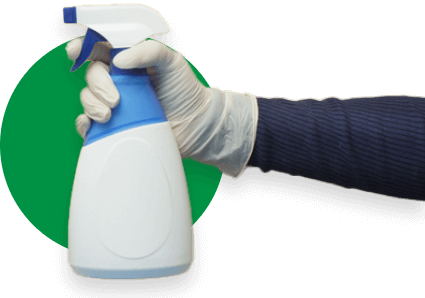With most of us finally back to work after the height of Covid, workplace cleaning is still as important as ever. Before the collective return to the office, 66% of employees said they wanted better office cleaning practices before going back to work.
To help reduce germs and the illnesses they cause going forward, most workplaces have embraced standard disinfection procedures. You know by now disinfecting is more than just having employees wipe down their desk areas at the end of the day. The job needs to be done right. So you should trust professionals to thoroughly disinfect the office, including hard-to-reach spaces.
A cleaning company should help walk you through the recommended disinfection steps for your office. But you need to know exactly which items to include on your standard and COVID-19 office disinfection checklist to keep people safe, healthy, and comfortable.
Keep reading to understand how to disinfect your office and why it’s important. We’ll provide a comprehensive disinfection guide and checklist with recommendations for specific surface types.
Why and How Should You Disinfect Your Office?
By killing the vast majority of germs, disinfection goes one step further than sanitizing. Anyone can simply wipe down their own desk and items with disinfecting cloths or spray, right? Why hire professionals to disinfect the office?
During the pandemic, employees were surveyed about the most important safety measures in helping them feel comfortable eventually coming back to the office.
The two most important precautions they ranked were regular cleaning of equipment and shared spaces by a cleaning service (64%) and regular spraying/fogging to disinfect shared spaces (60%).
The workforce likely went through the jarring transition of working exclusively from home for an extended time to spending at least 40 hours per week at the office again. And remember, Covid, the flu, common colds, and other bugs are still going around. So it’s only right to respect workers’ and visitors’ health, safety, and peace of mind with regular, effective office cleaning and disinfection.
Now, you may be wondering, how do I guarantee effective, exhaustive office disinfection? Before we answer this question in-depth with our comprehensive checklist for office disinfection, here are the most important points:
- Trust the professionals and their expertise
- Collaborate on a personalized office disinfection plan
- Implement disinfection procedures on a regular basis and in response to any outbreaks
- Use the appropriate disinfection materials for each surface
- Keep certain essential disinfection supplies on-hand
Office Disinfection Checklist: Comprehensive Guide
Here’s a comprehensive, step-by-step guide to follow for beginning or improving your office disinfection standards:
Step One: Trust the Professionals
Regarding the scope of your employees’ bare minimum expectations to clean up after themselves, there is a little bit of wiggle room. But correctly disinfecting the office to uphold health and safety standards is a job for the cleaning professionals.
Your team expects and deserves professional cleaning services. Because the experts go beyond merely wiping down the most obvious spots. They have the skills and equipment to kill germs in the air and inside nooks and crannies of upholstery, carpet, keyboards, and those tiny microphone holes in phones and headsets.
Find a professional cleaning service capable of meeting your criteria:
- Demonstrates the experience/expertise to clean your office
- Employs a dedicated cleaning team with low turnover for optimal consistency, familiarity, and security
- Utilizes appropriate disinfecting materials and methods for each surface (EPA List N), perhaps with the option of green/eco-friendly cleaning supplies
- Works with your scheduling needs
- Partners with you to establish an itemized plan and scheduled checklist for individual office disinfection and cleaning tasks
- Fits your budget
- Has earned a trusted reputation
Step Two: Develop Your Office Disinfection Plan
Before agreeing to any short- or long-term contract with a cleaning company, work together to come up with a disinfection system.
Do any surfaces need disinfection daily or multiple times daily? Which procedures can be less frequent, like top-to-bottom spraying/fogging/electrostatic disinfection? Your basic disinfection procedures are consistent for each day in your routine cleaning checklist for the office. Or they may vary with certain tasks taking place more often than others.
Either way, mutual communication between you and the cleaning team will keep you both on the same page as far as which disinfection tasks you expect and with what frequency.
Step Three: Prioritize High-Touch and High-Traffic Areas
So where should you ask your professional cleaners to focus on with more intensive and more regular attention? These areas and surfaces should be the top priorities on your checklist for office disinfection:
High-traffic areas:
- Entryways
- Elevators
- Restrooms
- Halls
- Reception and waiting areas
- Conference rooms
- Copier rooms
- Kitchens or break rooms
Frequent touch points:
- Door handles
- Railings
- Light switches
- Elevator buttons
- Touchpads
- Restroom fixtures
- Desks, tables, counters, and chairs
- Kitchen appliances and fixtures
- Office supplies
- Electronics
Step Four: Keep Disinfecting Supplies Handy
Keep an adequate stock of supplies like wipes, spray, paper towels, cloths, and hand sanitizer in key areas. Consider putting sanitizer by elevators and at building and room entrances. Additionally, placing common household disinfecting supplies near the kitchen sink, breakroom tables, cubicles, offices, and desks might lead to employees voluntarily wiping down surfaces before or after using them.
This is especially useful if someone at the office has recently called out sick or knows they’ve been in contact with someone who’s sick.
Step Five: Respond Promptly to Any Outbreaks of Illness
If someone’s sick, or worse, if an illness is already spreading through the workplace, it’s probably time to call your cleaning company.
This is why it’s important to work with professional cleaners who offer flexible and emergency availability with responsive customer service. Hopefully, they’ll be able to make an unexpected extra visit or alter their daily cleaning tasks to include top-to-bottom and airborne disinfecting, potentially sending additional personnel, equipment, and materials.
Here’s How To Disinfect Specific Types of Surfaces
Your cleaning service already knows the correct methods and supplies to use for different purposes. But before working together, you need to inform your cleaning company about the materials of your floors, counters, and furniture so they can accurately plan and price material-specific services and come prepared.
Here’s an overview, in case you and your employees are curious about how to disinfect various surfaces.
(Don’t expect employees to use any harsh or commercial cleaning supplies requiring training or expertise to use properly. Ensure employees observe the instructions and warnings on any familiar cleaning product labels you make available.)
Disinfecting Soft Surfaces Like Carpet and Upholstery
- For upholstery, clean the surface with soap, an approved soap or detergent for the type of fabric.
- Anything requiring laundering should be washed following manufacturer instructions with the warmest possible water setting before being completely dried.
- Use EPA List N disinfectants approved for use on soft surfaces.
- Vacuum carpets regularly.
Disinfecting Electronics
- Some electronics like remote controls might benefit from an easily wipeable plastic cover.
- Follow the manufacturer’s instructions and recommendations for cleaning any electronic device or appliance.
- Check EPA List N for disinfectants meeting manufacturer’s recommendations. Many of the products listed for electronics are alcohol-based so they quickly.
Disinfecting Open Areas
- Don’t worry about spraying any cleaning products in open outdoor areas such as walkways, as it’s not necessary, effective, or recommended.
- Outdoors, only high-touch plastic and metal surfaces like railings, seating, and dining surfaces benefit from cleaning.
What Office Disinfecting Supplies Should You Always Have?
Exactly which supplies your cleaning company brings with them and which they want you to provide may vary. Most likely, the professional cleaners will supply most if not all of their own cleaning and disinfecting materials. But here are some supplies you should always have ready just in case:
Microfiber Cloths
Multi-purpose microfiber cloths are washable, reusable, and can be used on just about any surface. You can wipe even wooden desks and tables without scratching, and dusting electronic devices while clearing static.
Gloves
Have disposable gloves on hand. This way, if an employee wants to clean up a mess they spilled on the floor, they can take care of it without directly touching the floor. They may also wish to disinfect their own work area or break room surfaces before or after eating without directly touching the cleaning products or making fingerprints.
Disinfecting Wipes
As we mentioned above, standard household disinfecting wipes go a long way when conveniently stored around the kitchen, breakroom, and work areas. Make sure to have disinfecting wipes that are suitable for electronics.
Follow These Tips to Keep Your Office Germ-Free
There’s no use investing in cleaning services that aren’t efficient or cost-effective. And there’s no use disinfecting the office only to let germs take over again with poor office hygiene or services that are too infrequent to help.
Outsource the Job to a Professional Cleaning Company
A study showed 46.42% of facility managers haven’t even considered the option of outsourcing their cleaning/janitorial services in the past 12 months. Meanwhile, there are significant, practical reasons to reconsider.
Your employees aren’t qualified, trained, or covered by insurance to do all the office cleaning. You can start a culture of workplace upkeep etiquette, but beyond that, let the workers focus on what they were hired to do.
Or perhaps you’re questioning whether it’s more viable to have your own in-house cleaning/janitorial service versus hiring an outside cleaning company.
For many businesses, it’s more efficient to simply hire a cleaning company. This is because it’s less of an administrative time and money investment compared to starting another entirely separate arm of your own business dedicated just to cleaning.
Encourage Office Hygiene
- Emphasize handwashing.
- Keep supplies like tissues and hand sanitizer readily accessible.
- Consider limiting eating to the kitchen or breakroom. Desks and keyboards are shockingly germ-ridden, and employees may be more likely to get sick eating at their desk.
- Expect basic kitchen/break room etiquette like keeping counters, tables, microwaves, refrigerators, coffee makers, and sinks free of food waste and messes.
- Consolidate trash daily, especially if cleaners don’t come through every single day.
- Have employees work from home when under the weather. With the prevalence of remote work, there’s no longer any reason to come into work sick.
Work from home or just take a sick day rather than exposing the whole office to germs that might sacrifice the productivity of the whole workplace in the long run.
Maintain a Frequent Cleaning Schedule
We all produce and distribute an unfathomable amount of germs every day, even when we’re not sick. It’s the whole principle behind employees pitching in with basic daily upkeep around the office.
It’s also the reason disinfecting and cleaning services are rendered useless if they’re not frequent and consistent enough. The industry standard is to clean three to five times per week.
Frequently Asked Questions
What is the best office disinfection to fight Coronavirus?
In many cases, simply washing with water and soap or detergent is sufficient to kill Coronavirus on surfaces. But disinfecting can actively kill the vast majority of germs on surfaces, in hidden spots, and in the air.
To control an office Covid outbreak, it’s best to disinfect all frequent touch points and high-traffic zones, or fully disinfect via spraying/fogging/electrostatic solutions.
How to choose between cleaning companies?
Choose a cleaning company fitting your budget, specific cleaning needs, and schedule. Look for a dedicated staff, strong reputation, and attentive customer service.
When and how to disinfect your office desks when returning to the workplace?
Regular cleaning 3-5 days per week should sufficiently kill most germs. But a full disinfection is in order when someone has gotten sick. Additionally, employees may feel more comfortable disinfecting their own desks, electronics, supplies, and dining areas daily before and/or after use.
How to clean and disinfect the house or office to avoid contagion?
Focus on high-touch surfaces and high-traffic regions. Don’t neglect things like upholstery, electronics, appliances, and sinks. Know which materials to use for different surfaces.
Save Your Energy and Leave the Disinfection to the Professionals
Do you need expert cleaning and janitorial services to take care of your Dallas-Fort Worth area business, its partners, and its workforce post-pandemic? At Dallas Janitorial Services, we can clean just about any type of facility. Benefit from improved health and safety standards, highly-qualified staff, and scheduling and services catered to your precise specifications. Contact us for a free quote.







